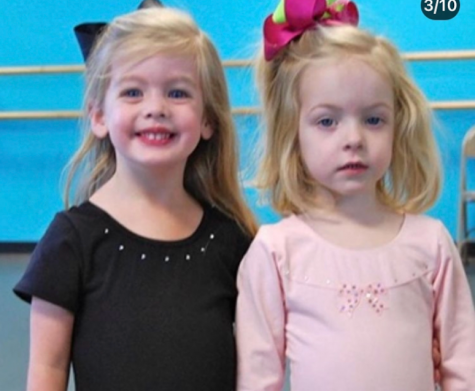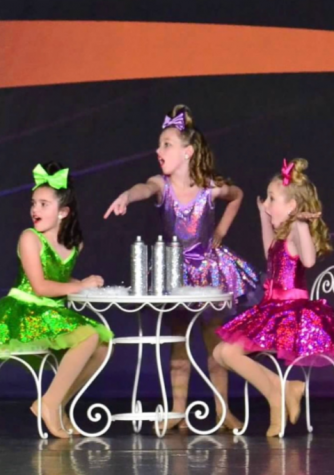‘Turning Out’ To Be A Dancer
Kaitlyn Fox
November 16, 2021
I take a deep breath and get into my starting position, pointing my feet and very slightly raising my hand. I’ve been at the studio for an hour and this ballet class was killing me. Miss is making us repeat the combination again. I know I’m not doing great, but who could blame me? I have my big math test tomorrow and I’m stuck at the studio until nine. My arms are sore, my feet feel like they’re about to fall off, and I need a minute to catch my breath, but then I hear Miss.

“Start over, and…” she claps her hands to the beat. My mind goes blank as I act out the tombe pas de bourree that’s been living in my mind on loop for hours. I finally nail the final turn and I smile. How could I ever hate a place that felt so much like home?
For dancers like Rowan Bullington, Liz Heath, and Kaitlyn Fox, this is an almost every day occurrence. Between practicing, lessons, and performances, these dancers eat, breathe, and sleep dance.
“If things are hard, you’ll always have dance,” Liz explained. “You can always go and just forget about all of the things you’re dealing with and have fun.”
Dance is a sport and also an art form. It’s great because it allows for physical training, a form of expression, a way to introduce yourself to different cultures, an awesome source for friends, and it’ll always be there. Bullington compared her love of dance to her love of poetry and writing by pointing out that they’re both healthy ways of expressing yourself and letting your feelings out that’ll always be there for you.
Fox even went as far as to describe her love of dance as her entire life. “I love dance, everything about me is dance. I mean at this point, I am dance, dance is me,” she confided.
These dancers, and many others like them, spend multiple hours every week at their dance studio perfecting their moves. Bullington has dance practices at least three times a week, while Heath has four. These classes can be long and since they often have multiple classes in one day, oftentimes the dancers don’t get home until nine or nine thirty every night.
Fox even says she’s in classes anywhere from 25 to 35 hours a week. They practice at least five or six days a week, on top of doing their own stretches and workouts at home. “I like to joke that my only personality trait is dance,” she laughed while she tried to explain her schedule.
Fox has even changed her school schedule around so that she can fit in more dance. After the pandemic began, her studio started offering a day time course since most students were doing virtual learning. Even after schools have opened back up, they’re continuing down the homeschooling path and keeping the class. Kaitlyn only has one in-person class and two self-paced virtual classes to keep up with on top of dance.
Dance schedules even affect school for dancers in traditional classes. After getting home late from their classes, Heath and Bullington still need to finish their homework, eat dinner, and prepare for the next day. Heath complains of how they never get to eat dinner with their family because of dance, but it’s something they’re willing to give up if it means becoming a better dancer.

Since all three of these dancers have been fitting dance classes into their schedule since they were three, they’ve found ways to deal with keeping up with it all. Heath’s best advice for new dancers struggling to manage long classes and excess homework is just to keep a schedule so that you can work on good time management.
They all have plans to continue dancing at least until graduation, and hopefully through college. Fox says she’s back and forth about what she wants to do with her life, but it will definitely have something to do with dance. Kaitlyn has plans to definitely go to college and possibly major in either dancing or choreography. They’d love to be a professional dancer in either ballet or contemporary, but as a dancer’s career is only around twenty years, a backup plan is necessary. She’s considering either becoming a physical therapist so that they can still help dancers or opening up their own studio so that she can teach kids how to dance. Whatever she decides, they ensure that it will definitely have something to do with dance.
More recreational dancers, like Rowan, plan on trying to do dance in their future, but it’s not their main priority. She proposes that she could possibly teach a small class one day a week on top of her main job.
It’s hard to plan for a future career when spending so much time at the studio. The dancers have to be very limited about what clubs they join because their main focus is on dance. Bullington tells me that the clubs she joins have the majority of their meetings during the school day. Heath, while in a rock band, can only participate in extracurriculars on Fridays and sometimes the weekend. They both say they would definitely join more clubs if they weren’t in dance.
Fox complains that while she loves dance with a passion, it’s hard to miss out on so many opportunities. Her friends get to have the full high school experience of going to football games and enjoying spirit weeks, while Fox has to miss out.

Even if Fox’s schedule is completely filled, they can’t cut back on classes because of her plans to go pro. Sharon Weighner, a professional dancer, says she dances around six to nine hours a day, five to six days a week. She only has around eight weeks off a year, which are filled doing extra classes and training for dance. If Kaitlyn wants to get to Weighner’s level, then she has to miss out on those little experiences.
Professional dancers are expected to be near perfect while performing, and they all had to go through long hours of practice to get to this point in their lives. Weighner mentions that even dress rehearsals are performed live to a small audience and broadcasted across 10 different countries.
Practice isn’t the only thing that goes into being a professional. On top of the loss of free time, sleep, and overlooked typical experiences, dancers have to watch their diet. It is essential for dancers to maintain a well balanced diet, eat lots of calories, and not underestimate their needed intakes as they live such an active lifestyle. Carbohydrates are important, as they’re a big source of energy. Dancers can get carbs through nuts, seeds, fruit, and vegetables. Protein is also important for building things like muscles. There are animal-based proteins like chicken, fish, beef, pork, dairy products, and more. There’s also plant-based options like nuts, peanut butter, quinoa, and more. Fat is important for the body to keep it full throughout the day and unsaturated fats help with muscle repair. Unsaturated fats can be found in oils, fatty fish, avocados, and more.
In their own personal experiences, the dancers say that their studios are big encouragers of healthy eating, but it’s still a pretty serious thing in the world of dance. Fox has friends at different studios where they weigh their dancers to make sure they’re maintaining a skinny build. Between this and toxic dance teacher sayings, eating disorders are common in the industry.
“You’re staring in the mirror for eight hours a day, sometimes negative thoughts slip into your mind,” Kaitlyn tells me. Rowan agrees that in her case it has nothing to do with the studio or teachers, it’s just a personal thing. The brain causes lots of comparisons between yourself and other dancers and there’s lots of negative thoughts asking yourself if you’re skinny enough for this. Liz says that dance really encouraged them to make healthier choices in their diet, but they can definitely understand how it would encourage eating disorders.
It is essential to drink a lot of water throughout the day, especially if you’re as active as dancers. Rachel Fine, a registered dietitian nutritionist and founder of the only dietitian-created nutrition program for dancers, says that dancers should aim to drink at least three liters of water a day (close to four 16 ounce water bottles a day). Liz, Kaitlyn, and Rowan all agree that they drink lots of water in a day, and even wish they drank more. Rowan says she drinks around one bottle for every class she’s in and Liz even says they drink around five bottles a day.

Dance is also a very expensive sport. From classes and travel fees from travelling for performances to pricey costumes and equipment. One of the easiest ways for a professional dancer to lose money is from buying all of their expensive shoes. While it does depend on how often dancers use their shoes and on what kind of surfaces, most professional pointe dancers use at least one pair of pointe shoes for every performance. When just basic pointe shoes are as expensive as $80-$110, this price adds up very quickly.
Dance takes a lot from you because it’s such an extensive sport. It brings up a lot of emotions for both dancers and audience members. Bullington tells me that depending on the style, dance can bring up all of your emotions. For example, lyrical and contemporary are very emotional and even a little depressing, while theatrical is a lot more fun and upbeat. Many dancers even say they often cry in dance because you think about your own personal life and try to convey that emotion to the audience.
As with any other activity with performances, there’s a lot of nerves that dancers experience. Oftentimes before a show you have to battle a lot of inner stress, and questions like ‘what if I mess up this combination’ and ‘what if I don’t do this right’.
In short, dance is a very challenging and draining sport and art form, but it’s also a great way to make friends, get physical activity, and express yourself. While it may be hard, finally getting to achieve the dream of being a dancer that you’ve had since you were a kid is worth it.
https://www.wevideo.com/view/2434898522
Day-To-Day Life As A Professional Ballerina. (2017). http://www.4dancers.org/2017/04/day-to-day-life-as-a-professional-ballerina/
Ballet FAQs | Atlanta Ballet. (2021). https://www.atlantaballet.com/resources/ballet-faqs
Fine, R. (2021). A Dancer’s Diet | The Importance of Nutrition for Dancers
https://pointenutrition.com/the-importance-of-nutrition-for-dancers
L. Heath, Dance Student, October 25, 2021
R. Bullington, Dance Student, October 25, 2021
K. Fox, Dance Student, October 26, 2021



